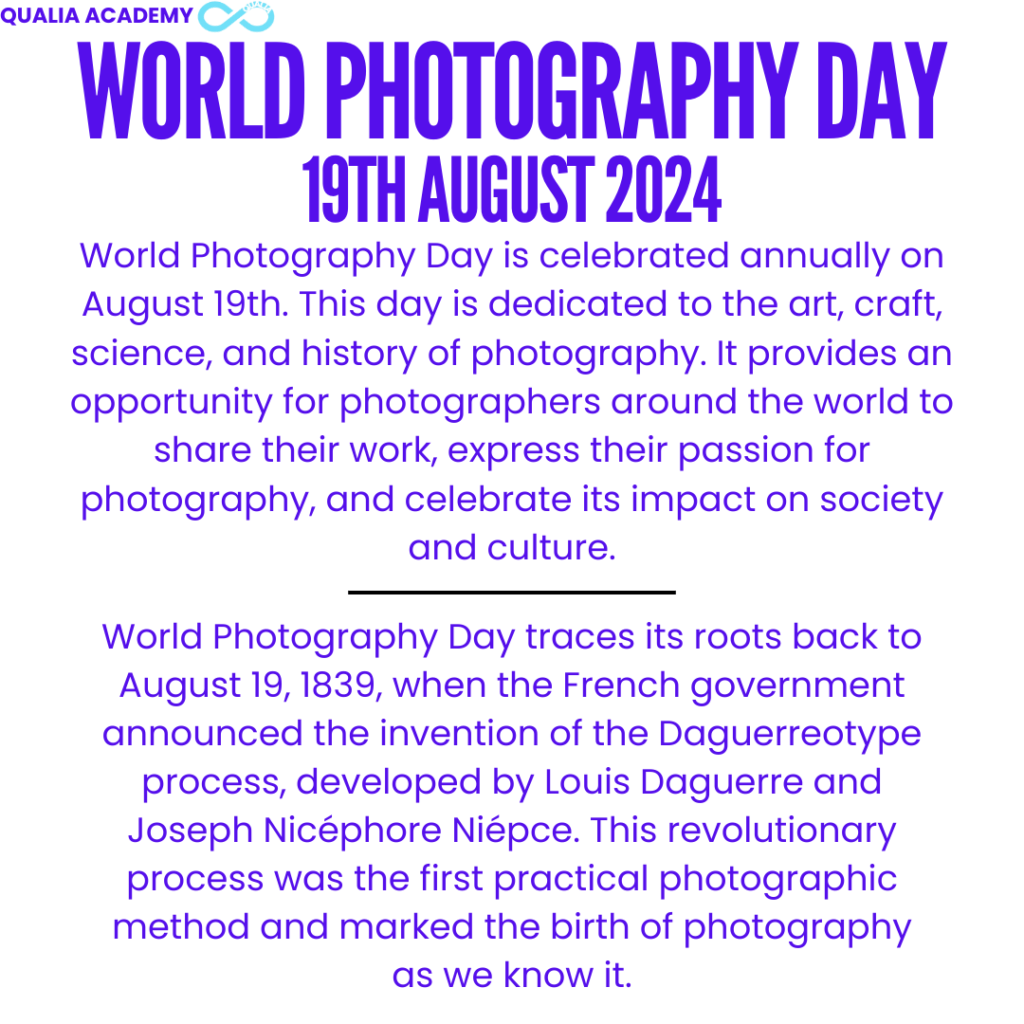
World Photography Day is celebrated Every year on August 19th, this day is dedicated to the art, science, and history of photography. This day not only honours the pioneers of photography but also recognises the countless photographers who capture moments, tell stories, and document our world in ways that words often cannot. In this blog, we’ll explore why this day is significant, the importance of photographers, the value of photographs in content, and the rich history of photography.
Why World Photography Day is Celebrated
World Photography Day traces its roots back to August 19, 1839, when the French government announced the invention of the Daguerreotype process, developed by Louis Daguerre and Joseph Nicéphore Niépce. This revolutionary process was the first practical photographic method and marked the birth of photography as we know it. The announcement was made public, and the French government offered the Daguerreotype process as a gift “free to the world,” fostering a global appreciation and practice of photography.
Since then, August 19th has been celebrated as World Photography Day, a day to appreciate how photography has evolved over the years and its profound impact on our lives. It’s a day for photographers to share their work, for amateurs to pick up their cameras, and for everyone to acknowledge the beauty and significance of captured moments.
The Importance of Photographers
Photographers play a crucial role in our society. Their work goes beyond taking pictures; they capture emotions, tell stories, and document history. Here are a few reasons why photographers are so important:
Preserving Memories:
Photographers capture moments that become lifelong memories. From family portraits to wedding photographs, these images allow us to relive significant moments and preserve our personal histories.
Documenting Events:
Photojournalists play a vital role in documenting events, whether they are local community happenings or global news stories. Their work informs the public, raises awareness, and can even inspire change.
Artistic Expression:
A Photograph is a form of art that allows for creative expression. Photographers use their skills to create visually stunning images that evoke emotions and provoke thought.
Cultural Documentation:
Through their lenses, photographers document different cultures, traditions, and ways of life. This documentation is essential for preserving cultural heritage and fostering understanding and appreciation of diversity.
Scientific Contribution:
Photography is also crucial in the scientific community. From capturing images of microscopic organisms to documenting astronomical phenomena, photography aids in scientific research and education.
The Importance of Photographs in Content
In today’s digital age, visual content is more important than ever. Here’s why photographs are essential in content creation:
Increased Engagement: Articles, blogs, and social media posts with images receive significantly higher engagement than those without. Visual content attracts attention, encourages interaction, and is more likely to be shared.
Improved Understanding: Images can help explain complex concepts and ideas more effectively than text alone. They provide context and clarity, making the content more accessible and understandable.
Emotional Connection: Photographs can evoke emotions and create a connection with the audience. This emotional engagement can drive interest and loyalty to the content and the brand.
Enhanced SEO: Including images in content can improve search engine optimisation (SEO). Properly tagged and described images can help increase visibility in search engine results, driving more traffic to the content.
Storytelling: Photograph enhance storytelling by adding a visual element that complements the narrative. They help to create a more immersive and engaging experience for the audience.
The History of Photographs
The history of photographs is rich and fascinating, marked by numerous innovations and milestones:
Early Experiments:
Before the Daguerreotype, there were early experiments in capturing images. In 1826, Joseph Nicéphore Niépce created the first permanent photograph using a process called heliography. This image, “View from the Window at Le Gras,” required an eight-hour exposure.
The Daguerreotype:
Announced in 1839, the Daguerreotype was the first commercially successful photographic process. It produced a single image on a silvered copper plate and required long exposure times, but it was a significant leap forward.
Calotype and Other Processes:
Shortly after the Daguerreotype, William Henry Fox Talbot introduced the Calotype process, which created a negative image on paper, allowing for multiple positive prints. This was the precursor to modern photographic processes.
Wet Plate and Dry Plate Photography:
The 1850s and 1860s saw the development of wet plate collodion photography, which required images to be developed quickly after exposure. This was later replaced by dry plate photography in the 1870s, which was more convenient and allowed for more flexibility.
The Kodak Revolution:
In 1888, George Eastman introduced the Kodak camera, which used roll film and made photography accessible to the general public. Eastman’s slogan, “You press the button, we do the rest,” highlighted the simplicity of the process.
Colour Photography:
The early 20th century saw the advent of colour photography, with the Autochrome Lumière being one of the first commercially successful colour processes. This paved the way for modern colour photography.
Digital Photography:
The late 20th century and early 21st century have been dominated by the rise of digital photography. Digital cameras and smartphones have made photography more accessible than ever, allowing anyone to capture and share high-quality images instantly.
Celebrating World Photography Day
World Photography Day is a time to celebrate the art and impact of photography. Here are a few ways you can participate:
Share Your Photos: Post your favourite photograph on social media using the hashtag #WorldPhotographyDay. Share your unique perspective and see how others view the world through their lenses.
Attend Exhibitions and Workshops: Many galleries and organisations host photograph exhibitions and workshops on this day. It’s a great opportunity to learn, get inspired, and connect with other photograph enthusiasts.
Reflect on Photography’s Impact: Take some time to reflect on how photography has influenced your life and the world around you. Consider the photographers who have inspired you and the moments you’ve captured that hold special meaning.
Support Photographers: If you appreciate the work of a particular photographer, support them by purchasing prints, sharing their photographs, or simply giving them a shout-out on social media.
World Photography Day is a celebration of the art, history, and power of photography. It’s a day to acknowledge the contributions of photographers, the importance of visual content, and the rich history that has shaped the field. Whether you’re a professional photographer, an amateur enthusiast, or simply someone who appreciates the beauty of a well-captured moment, World Photography Day is a day to celebrate the incredible impact of photography on our lives.









